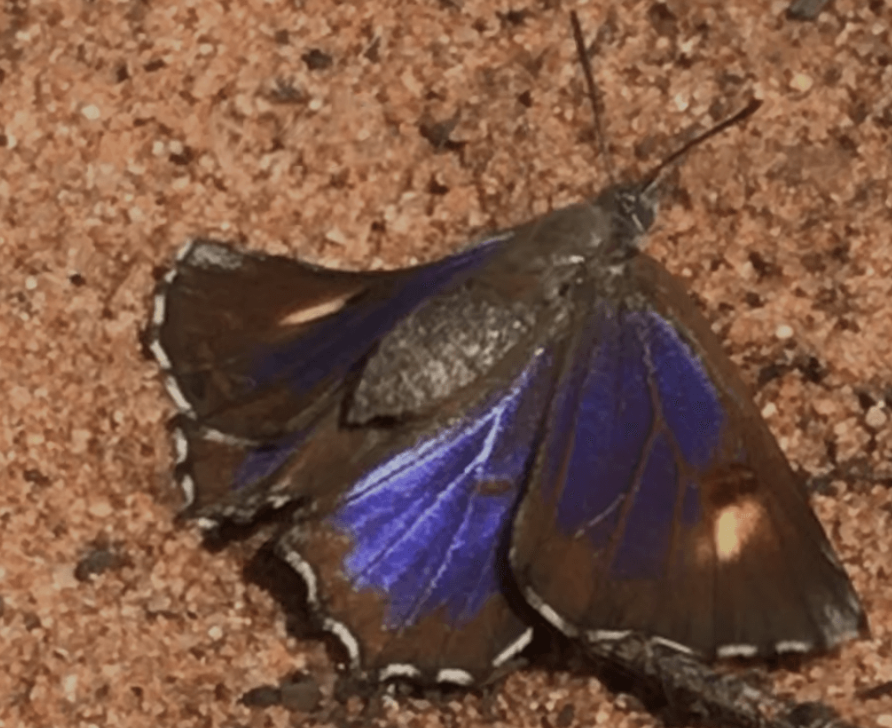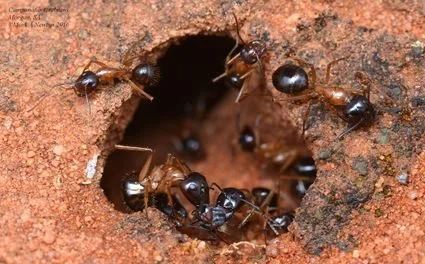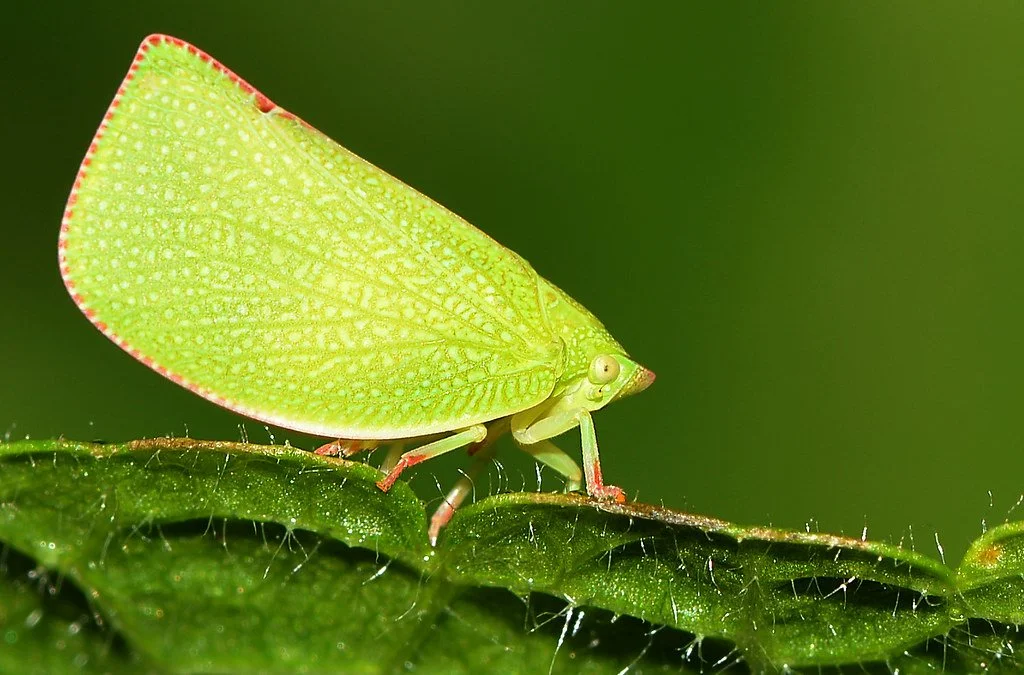In the Classroom
Meet a Rare Butterfly
https://www.dmp.wa.gov.au/News/Critically endangered-butterfly-30633.aspx
The Arid Bronze Azure Butterfly Ogyris subterrestris petrina (10) has an intimate relationship with an ant, the pale form of the Sugar ant (Campanotus sp.).
In the eastern Wheatbelt region, near Mukinbudin, these ants have make their nests at the base of particular species of eucalypt tree, a smooth barked gimlet (Eucalyptus salubris).
This relationship is well-known to the Noongar (see Story below), and introduces students to the biological term ‘symbiosis’, which can be defined as ... ‘an interaction between 2 different organisms living in close physical association, typically to the advantage of both.’
EXPLORING THE RELATIONSHIPS – INTRODUCING SYMBIOSIS
• The female butterfly lays her eggs at the base of the gimlet, near the entrances to the ants’ nest. In the evening the eggs hatch as tiny larvae, which trick the ants to carry them down into the nest. How do they do this? The larvae secrete an airborne chemical (or pheromone) that causes the ants to mistake them for their own larvae.
• The larvae live underground for about a year, eating, and growing. What do they eat? As carnivores, they eat their host’s larvae and pupae! They are also fed by the ants themselves, who regard them as their own larvae, and feed them a liquid by mouth. Totally tricked!
• What benefit do the ants get for taking in the imposters? The larvae develop secretions from an organ on their dorsal surface (dorsal nectary organ) that produces a secretion rich in sugar, and provides food for the ants. There is a ‘secret weapon’ in this secretion. Scientists have discovered it contains a chemical that acts in the ants’ brains, making them ‘addicted’ to the larvae. This ensures that the ants will always stay close. (10)
• There is another trick the larvae have. Further down their body, is an organ that secretes a substance resembling the ants’ alarm pheromone (an airborne chemical that one can smell). Not only are the ants ‘addicted’ to the larvae, but they are also tricked into remaining ‘on guard’, becoming their protectors.
• When fully developed, the larvae pupate inside the ants’ nest. When the butterfly emerges, it has to be quick to escape, as it does not have the defence mechanisms of the larva.
When two organisms (in this case, the ant, and the butterfly) have a relationship in which each benefits the other, it is known as symbiosis.
Activity
Research the Account of the Arid Bronze Butterfly and List how the Butterfly and the Ant Help Each Other
• the ants help the butterfly by taking her eggs into their nest and protecting them from predators
• the ants help the larvae by feeding them
• the larvae help the ants by providing them with food from their nectary organ
• How do the larvae persuade the ants to keep looking after them?
• They feed the ants a chemical that tricks the ants into thinking the larvae are their own
• They also trick the ants with another chemical that mimics the ants’ alarm system, making quite sure the ants will protect them if there is danger.
NOW MEET A THIRD MEMBER IN THE PARTNERSHIP
There is another inhabitant in the ants’ nest – a leafhopper.
This is a complication to the partnership between the butterfly larvae and the ant. In fact, scientists say that “for both caterpillar (the larva) and the leaf hopper (adult) to occur together in a single ant (adult) nest is possibly unique.”(10)
1. The ants are nocturnal and lead the leaf hoppers from the nest to feed on the gum leaves above during the night.
2. The leaf hoppers have piercing and sucking mouthparts and feed on the young gum leaves.
3. The ants stay with the leaf hoppers and feed from their excretions.
4. When disturbed, the ants were observed to shepherd the leaf hoppers down from the tree and back into their nest.
• These ants are busy. They appear to have both night and day jobs. By night, they are in the tree above, allowing the leaf hoppers to feed, but also feeding themselves from the leaf hoppers’ excretions. By day, they are in their nest, feeding from the butterfly larvae, who have persuaded the ants to care for them until they pupate and become an adult.
• This arrangement for the ants could be called ‘hedging one’s bets’. If the butterfly doesn’t drop her eggs near their nest, there’s always the leaf hopper to feed from. And vice versa, if the leaf hoppers don’t appear, hopefully there will always be an Arid Bronze Azure butterfly – but will there?
From: https://library.dbca.wa.gov.au/static/Journals/080052/080052-25.034.pdf
THE BUTTERFLY’S FUTURE
• The Arid Azure Bronze Butterfly is extremely rare – it is listed as Critically Endangered under Australia’s Environment Protection and Biodiversity Conservation Act (1999) and under Western Australia’s Biodiversity Conservation Act (2016).
• The only extant (living) population is within the Barbalin Nature Reserve in the northern Wheatbelt of WA, and is the subject of a Monitoring Program for both the butterfly and the ‘pale form’ of the sugar ant Camponotus terebrans (10) by the Department of Biodiversity, Conservation and Attractions (DBCA).
• Their health is also monitored by the Mukinbudin Conservation Group.
• Both the butterfly and the ant are sensitive to clearing and habitat disturbance, whether by roadworks, off-road vehicles, mining and agricultural activities, and inappropriate fire regimes.
All information is taken from a Workshop Report, 2022, Arid Bronze Azure Butterfly.
https://wabsi.org.au/wp-content/uploads/2022/10/ Arid-Bronze-Azure-Butterfly-WABSI-Report.pdf
Activity
Why Insects are Successful
• Using information from the examples above, or others that students have studied or researched, list the features they consider have contributed to the success of insects, explaining why each is important.
• Some aspects they may consider:
• insects are small and don’t need much to eat.
• they lay a lot of eggs.
• they know where to put their eggs and be protected.
• they have developed different ways of eating such as chewing wood or sucking nectar from flowers, or eating other insects (if they are a carnivore).
• or live together and help each other in a colony.
• or have wings and search for food.
• or live mostly underground and eat underground food.
• know when food will be plentiful and emerge as an adult.
• grow slowly, or know when to grow fast.
• all of the above, or more.
• They may conclude with actions that humans can do to ensure their continued success.
The Arid Bronze Butterfly
Sugar Ant
Leaf Hopper
A Story About a Butterfly, the Ant, and the Gimlet
A Noongar tale about totems, as told to Tyson Yunkaporta (11)
… “Old Nyoongars and Yorgas in Perth tell stories about a group of three totemic entities that work together in miraculous ways. Certain butterflies always lay their eggs on a particular bush above the nest of a particular species of ant. The ants collect the eggs and take them down into the nest. When the larvae hatch, the ants carry them up to eat the leaves of the bush at night and then carry them back down again. When they grow too heavy to carry, the ants bring the leaves down to them. The larvae grow a jelly on their sides when they eat those particular leaves, and this is the food that the queen ant eats. The larvae then spin cocoons in the nest for the final stage of the process, after which they fly out of the nest as butterflies and begin the cycle all over again...”(p82).
About totemic events - as told by Steve van Leeuwin
(pers. comm.)
… “Why would a small moth be totemic? - perhaps because when it emerges and f lies, this event coincides with a change in seasons and thus is an indicator of change in the Noongar calendar, just as the commencement of marri flowering indicates progression to the Noongar season of Djeran.
If we are talking about the Graceful Sun moth, on the Swan Coastal Plain, then its presence in bushland at the end of February and early March may have indicated the end of hot weather – the season of Bunuru. The presence in bushland of the Bronze Azure butterfly, which typically flies in early November to December, and again in March April, may have been taken to signify the beginning and the end of the hot dry seasons – Birak & Bunuru.
There is still a lot we don’t know and, excitingly, a lot to learn...”



